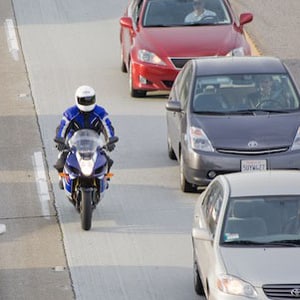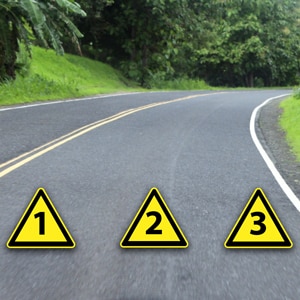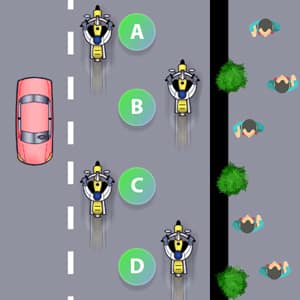Alabama Motorcycle License Practice Test 7
PASSENGERS SHOULD:
WHAT IS THE BEST WAY TO AVOID HAZARD WHILE RIDING A MOTORCYCLE?
IF YOU NEED TO SLOW DOWN WHILE TURNING:
If you know the technique, using both brakes in a turn is possible, although it should be done very carefully. When leaning the motorcycle some of the traction is used for cornering. Less traction is available for stopping. A skid can occur if you apply too much brake.
CARS AND MOTORCYCLES CAN SHARE HOW MANY LANES?

Riding between rows of stopped or moving vehicles in the same lane can leave you vulnerable. A vehicle could turn suddenly or change lanes, a door could open, or a hand could come out a window.
WHEN PREPARING TO PASS, IT IS USUALLY BETTER TO:
When preparing to pass, ride in the left portion of the lane at a safe following distance to increase your line of sight and make you more visible. Signal and check for oncoming traffic. Use your mirrors and turn your head to look for traffic behind.
WHEN A MOTORCYCLE IS STOPPED AT AN INTERSECTION, A PASSENGER SHOULD:
The passenger must keep both feet on the footrests, even when the motorcycle is not moving. This will help the rider to keep the bike balanced and even.
IF YOUR MOTORCYCLE STARTS TO WOBBLE:
Trying to accelerate out of a wobble will only make the motorcycle more unstable. Instead, grip the handlebars firmly, but do not fight the wobble. Roll off he throttle gradually to slow down.
TO AVOID CONFUSING OTHER DRIVERS YOU SHOULD:
IF YOU DRINK 4 TYPICAL DRINKS, WHAT IS THE LEAST AMOUNT OF ALCOHOL REMAINING IN YOUR BODY AFTER 2 HOURS?
Generally, alcohol can be eliminated in the body at the rate of almost one drink per hour, however a variety of other factors may also influence the level of alcohol retained. The formula does not take into account other factors, such as your weight, hydration level and alcohol tolerance.
IF YOU SEE OR HEAR A TRAIN APPROACHING, YOU SHOULD:
THE BEST GEAR TO WEAR TO BE SEEN AT NIGHT IS:
Wearing reflective clothing at night gives you a better chance of being seen by other drivers.
KEEPING A CUSHION OF SPACE AROUND YOUR MOTORCYCLE:
Provide a space cushion around the motorcycle that permits you to take evasive action. The larger this space cushion is, the more time you will have to react to a hazard.
TO ADJUST FOR TRAFFIC AND AVOID DEBRIS IN THE CURVE PICTURED, RIDE:

One of the alternatives is to move to the center of your lane before entering a curve — and stay there until you exit. This permits you to spot approaching traffic as soon as possible. You can also adjust for traffic “crowding” the center line, or debris blocking part of your lane.
TO EXECUTE A TURN SAFELY A MOTORCYCLE RIDER SHOULD ALWAYS:
To execute a turn safely, the motorcycle should always lean in the direction of the turn. For normal turn, lean with the motorcycle. In slow turns, counterbalance by keeping your body straight.
IN THE PICTURE, RIDERS ARE IN A STAGGERED FORMATION. THE FOLLOWING DISTANCE BETWEEN A AND C SHOULD BE AT LEAST:

A close group takes up less space on the highway, is easier to see and is less likely to be separated. While riding in a staggered formation, stay two seconds behind a rider directly in front of you.
APPROXIMATELY HALF OF ALL MOTORCYCLE CRASH FATALITIES ARE CAUSED BY:
Driving under the influence is one of the major contributors to motorcycle crashes. Injuries occur in 90% of motorcycle crashes that involve abuse of substances.
THE BEST WAY TO HELP OTHERS SEE YOUR MOTORCYCLE IS TO:
Motorcycles manufactured during or after 1973 are required by law to use headlights at all times. The headlight is the best way to help others see you. Studies show that during the day, a motorcycle with its light on is twice as likely to be noticed.
FOR GREATEST SAFETY, YOUR HELMET SHOULD:
In order for the helmet to do its job, it needs to fit snugly all the way around. Your head should not move and bang against the insides of the helmet.
TO STOP ON WET PAVEMENT:
Use both brakes to stop on wet pavement. The front brake is still effective, even on a slippery surface. Squeeze the brake level gradually to avoid locking the front wheel and apply gentle pressure on the rear brake.